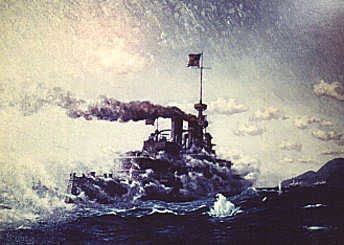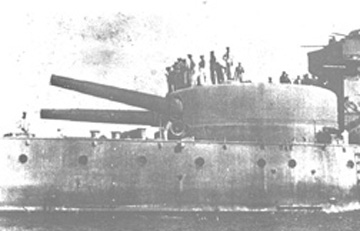 After coaling
and resupplying, the Oregon departed Key West around 1:00
am on May 29 to join Admiral Sampson's fleet. Later that day,
the Oregon joined the fleet and was enthusiastically greeted
by the other ships. Oregon's crew, still dirty with the
black coal dust, cheerfully returned the greetings. The Oregon
was ready for action.
After coaling
and resupplying, the Oregon departed Key West around 1:00
am on May 29 to join Admiral Sampson's fleet. Later that day,
the Oregon joined the fleet and was enthusiastically greeted
by the other ships. Oregon's crew, still dirty with the
black coal dust, cheerfully returned the greetings. The Oregon
was ready for action.
It was soon discovered that the Spanish fleet was in Santiago Harbor. The American fleet quickly blockaded the harbor and eagerly awaited for the Spanish fleet to sortie out. Unfortunately for the Americans, Admiral Cervera y Topete of the Spanish Navy would not oblige the Americans. Over the next month, the Americans maintained the blockade of the harbor and performed shore bombardment of the Spanish batteries. The action was not quite what the Americans expected, but it was at least action and the American ships did take some damage. The Oregon's main mast was struck by a piece of shrapnel and the Massachusetts received one direct hit, although the hits did not cause any serious damage.
Sunday morning, July 3, 1898. The day started off bright and clear and was shaping up to be another hot day off the harbor. At 8:45 am, Admiral Sampson in flagship USS New York moved off to the East in order to participate in a conference with General Shafter a few miles down the coast at Siboney and the USS Massachusetts sailed to Guantanamo to recoal. The blockading American ships closed in to fill the gap left by New York and Massachusetts.
The Americans crews were carrying out the usual Sunday routine: Breakfast, ship cleaning, morning inspections in white uniforms, and finally church services. This routine had been carried out on the ships since arriving in Cuban waters. Today would proved different.
9:28 am. As with all the other ships in the fleet, the men of the Oregon were preparing to muster in their divisions. Captain Clark was just going out on the decks, when suddenly the ships gong rang furiously. The Oregon's senior quartermaster spotted the masthead of a ship sailing out of the harbor. At about the same time an officer on the Iowa spotted the Spanish ships. Flags ran up the mast and a six pounder gun was fired to alert the other ships. The Oregon shuddered as she started to accelerate in order to enter the fray. Soon the American sailors on all the ships were scrambling to their battle stations. The fight was on.
Unlike the other ships in the fleet, which had secure their engineering plants, Chief Engineer Milligan had left the Oregon's steam pressure up. This enable the her to quickly accelerate and close the range with the fleeing Spanish fleet. "There goes Oregon, like a bulldog with a great white bone in her teeth", remarked one officer onboard USS Iowa. The Oregon opened fired with her eight inch guns on the Spanish destroyers, then the cruisers, as each of the Spanish ships came within range. Soon thereafter, the thirteen inch guns roared in anger and commenced firing. The speed of Oregon came to full steam and she was soon outstripping the American fleet except for the USS Brooklyn, the on-scene flagship which was also running at near full speed. The Iowa, Texas, and Indiana followed the two leading American ships as soon as steam pressure came up and were soon engaged in the running sea battle. New York with Admiral Sampson onboard heard the gunfire and soon turned around to engage the escaping Spanish fleet.
One by one the Spanish ships were taken under a withering storm of American shells and were forced to abandon their run to the open sea and instead turn toward the safety of the Cuban coast. The Spanish ships returned fired, but the volume of fire could not match the fire from the American guns. The Oregon and the Brooklyn engaged each ship and continued to pursue the eluding Spanish vessels forcing them to turn toward land. Iowa, Texas, Indiana and the New York also engaged and administered the coupe de grace to the Spanish ships. First the Infanta Maria Teresa (Admiral Cervera's flagship) slowed and turn to break action. Next was the Almirante Oquendo, then the Vizcaya. Only the Cristobal Colon, the fastest in the Spanish fleet remained. The great chase began.
 The
Colon, the newest and fastest ship in the Spanish inventory,
was already six miles ahead when the Oregon and Brooklyn
took up the chase. Slowly the two American warships gained on
the Colon. The Colon at times looked for a safe
haven somewhere on the beach but continued her flight down the
coast. The Oregon and Brooklyn fired eight inch
shells at Colon and Colon in turn replied. All shots
fell short. As the Oregon came within main battery range,
she commenced firing with her thirteen inch guns. The engineers
heard the great guns fire and work furiously to speed Oregon
up. Chief Engineer Milligan gave the order to use the precious
Cardiff coal and the speed of the Oregon increased. Slowly
but surely, the "Bulldog" gained on the fleeing Spaniard.
Shortly before 1:00 pm, a thirteen inch shell dropped in front
of Colon at a range of five miles. She immediately turned
to the coast. A few minutes later another shell struck under the
stern of the evading Spanish ship. She lower her colors and surrendered.
The Oregon's band began to play the "Star Spangled
Banner". The
day had been won.
The
Colon, the newest and fastest ship in the Spanish inventory,
was already six miles ahead when the Oregon and Brooklyn
took up the chase. Slowly the two American warships gained on
the Colon. The Colon at times looked for a safe
haven somewhere on the beach but continued her flight down the
coast. The Oregon and Brooklyn fired eight inch
shells at Colon and Colon in turn replied. All shots
fell short. As the Oregon came within main battery range,
she commenced firing with her thirteen inch guns. The engineers
heard the great guns fire and work furiously to speed Oregon
up. Chief Engineer Milligan gave the order to use the precious
Cardiff coal and the speed of the Oregon increased. Slowly
but surely, the "Bulldog" gained on the fleeing Spaniard.
Shortly before 1:00 pm, a thirteen inch shell dropped in front
of Colon at a range of five miles. She immediately turned
to the coast. A few minutes later another shell struck under the
stern of the evading Spanish ship. She lower her colors and surrendered.
The Oregon's band began to play the "Star Spangled
Banner". The
day had been won.
Above: A painting of the USS Oregon at full speed, flags flying from the main mast and after bridge, during the chase for the Spanish cruiser Cristobal Colon. Courtesy: Oregon Maritime Center and Museum.
 The
battle between the American fleet and the Spanish Fleet was decidedly
one-sided in favor of the Americans and resulted in an overwhelming
American victory. The entire Spanish fleet of four armored cruisers
of modern European design and three destroyers were sunk or severely
damaged. 160 Spanish sailors lost their lives and about 1700 sailors
captured. The American Fleet of three battleships, two cruisers,
and three gunboats, on the other hand, suffered minor damage to
its ships, and one crewman killed and one wounded.
The
battle between the American fleet and the Spanish Fleet was decidedly
one-sided in favor of the Americans and resulted in an overwhelming
American victory. The entire Spanish fleet of four armored cruisers
of modern European design and three destroyers were sunk or severely
damaged. 160 Spanish sailors lost their lives and about 1700 sailors
captured. The American Fleet of three battleships, two cruisers,
and three gunboats, on the other hand, suffered minor damage to
its ships, and one crewman killed and one wounded.
Above: Turret gunners from the aft 13 inch turret of the Oregon observe the final moments of the Cristobol Colon after the battle. Note the guns at the upper right of the photograph.
Courtesy: U. S. Naval Institute
Battle map and final position of Spanish ships